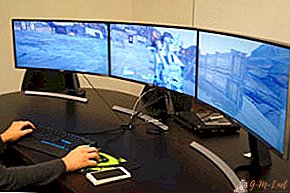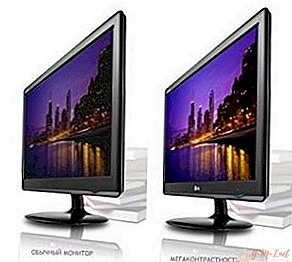Today we help you choose a monitor and not get lost in the sea of models, design, characteristics. So, let's get started and find out what your choice should be.

Main settings
- Diagonal monitor.Size in inches (1 inch - 2.5 cm) Characteristic that affects comfort, usability. The larger the diagonal, the more convenient it is to work with tables, graphics, texts. But they impose certain requirements on the graphics card, are more expensive. As the users themselves say, the diagonal of 18 ”is small, 19-22” is the norm, 23 ”and higher is large and what a“ wow ”.
IMPORTANT. Experts advise taking a model from 24 ”- it’s convenient to work on them, watch a movie, play. The monitor has a long lifespan - so why limit this time?
 Design. This is one of the parameters, eye-catching, but which is not worth attention. The steeper the design, the usually worse the user specifications, the price is higher. The proverb about checkers or go is relevant.
Design. This is one of the parameters, eye-catching, but which is not worth attention. The steeper the design, the usually worse the user specifications, the price is higher. The proverb about checkers or go is relevant.- Resolution screen aspect ratio. Modern monitors are made for most games, films, programs - they are narrow and wide. Format 16: 9, 16:10. The resolution is standard HD - 1366 × 768, FullHD - 1920 × 1080, WQHD -2560 × 1440, UltraHD - 3840 × 2160. Depending on your needs, choose a monitor with a resolution - from small HD to large, huge with WQHD, UltraHD.
- Grain. It determines the quality of the picture - the larger, the sharper the font, but the image will float, the lower it will be - on the contrary, the image will be clearer, more realistic, but the complexity of working with small print. Modern monitors use a scaling program that partially removes this problem.
IMPORTANT. If you have vision problems, then you should not take screens with small, medium grit - it is not comfortable to work with text. Scaling will not completely solve the problem - the picture floats from the adjustment.
- Angle review. The problem of modern devices is that you deviate from the screen by a certain angle - image distortion occurs. There is also some distortion of the picture in the corners. It practically does not appear in devices with a viewing angle of 160 * vertically, 170 * horizontally.
- Unevenness backlight. A disease of old models and ultra-thin screens. In expensive models it is visible if you conduct a test. Life does not spoil.
Minor Selection Criteria
Other, undoubtedly important, but not critical parameters:
 Embedded stereo speakers - A convenient fixture, but will not be able to fully replace the speakers. Sound is more suitable for games than for movies.
Embedded stereo speakers - A convenient fixture, but will not be able to fully replace the speakers. Sound is more suitable for games than for movies.- Inputs. The universal and most popular HDMI input is for transmitting video and sound in good digital quality (much better than through VGA). DVI - video transmission interface, but without sound.
- Three-dimensional graphics. Monitors that allow you to plunge into virtual reality. Good for new movies, games.
It is worth taking the choice of a monitor seriously, because this is an important part of the computer that costs money and cannot be upgraded - just buy a new one.

 Design. This is one of the parameters, eye-catching, but which is not worth attention. The steeper the design, the usually worse the user specifications, the price is higher. The proverb about checkers or go is relevant.
Design. This is one of the parameters, eye-catching, but which is not worth attention. The steeper the design, the usually worse the user specifications, the price is higher. The proverb about checkers or go is relevant. Embedded stereo speakers - A convenient fixture, but will not be able to fully replace the speakers. Sound is more suitable for games than for movies.
Embedded stereo speakers - A convenient fixture, but will not be able to fully replace the speakers. Sound is more suitable for games than for movies.
Leave Your Comment